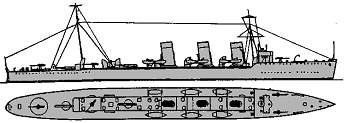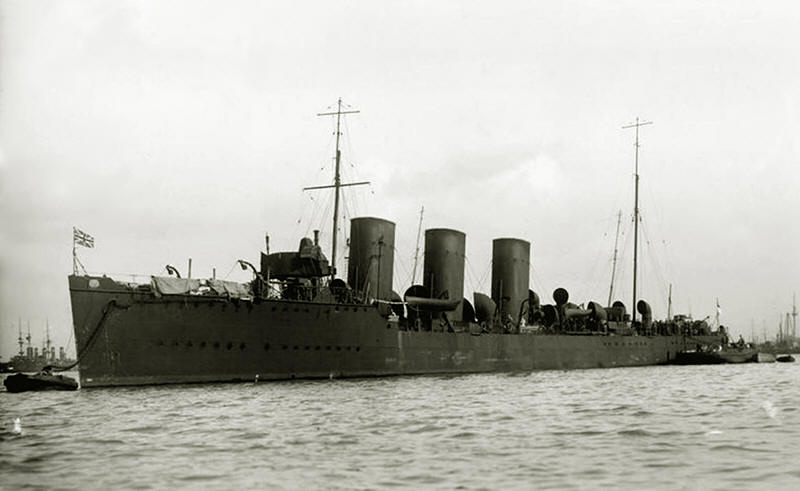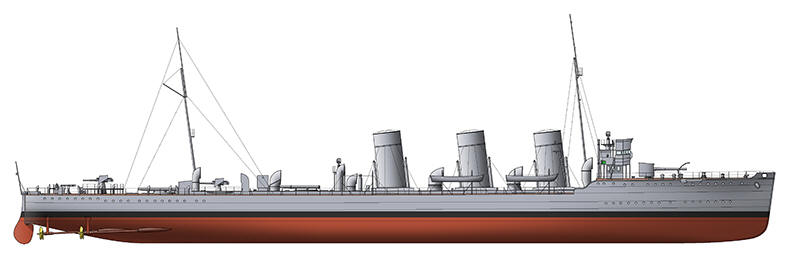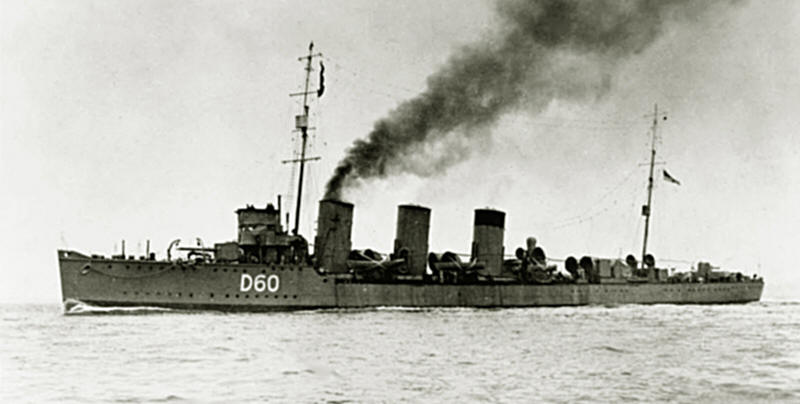

Swift 1910
|
Name |
No |
Yard No |
Builder |
Laid down |
Launched |
Comp |
Fate |
| Swift (ex-Flying Scud) | H54, H3A, D60 | 671 | Cammell Laird, Birkenhead | 10.1906 | 7.12.1907 | 2.1910 | sold for BU 11.1921 |
|
Displacement normal, t |
2170 |
|
Displacement full, t |
2390 |
|
Length, m |
107.8 oa 105.2 pp |
|
Breadth, m |
10.4 |
|
Draught, m |
3.20 |
|
No of shafts |
4 |
|
Machinery |
4 Parsons steam turbines, 12 Laird boilers |
|
Power, h. p. |
30000 |
|
Max speed, kts |
35 |
|
Fuel, t |
oil 282 |
|
Endurance, nm(kts) |
|
|
Armament |
4 x 1 - 102/40 BL Mk VIII, 2 x 1 - 450 TT |
|
Complement |
126 |
Project history:
At Admiral Fisher's instigation the Controller asked DNC in October 1904 to
produce a design for a destroyer based on the 'River' class bur capable of
36kts, using turbines and oil or coal. The DNC's reply was predictable;
the hull weight was inadequate, as it was no more than 20t
heavier than the previous turbine-driven destroyer (HMS
Eden) and would have less strength than the 30-knotters. In January
1905 a revised design was rushed through at two hours' notice: displacement was
up to 1140t and 19,000shp would give 33.5kts. To meet
the First Sea Lord's request for 2.5kts more a second
legend was prepared shortly afterwards: 1350t and 29,000shp.
The specialist firms were not happy with the invitation to tender, particularly
as they were given only four weeks to produce a design. Only after considerable
argument was the Cammell Laird design accepted in December 1905, but with the
builders' proviso that many amendments would be needed. Guns were changed from
12pdr to 102mm, sided on the forecastle and two on the
centreline aft. The name Flying Scud was
dropped in April 1906.
Trials proved that the design was
over-ambitious, and despite endless changes of
propellers, raising the funnels and other expedients she failed to reach her
contract speed, and was good for just a fraction over 35kts. The cost was heavy
oil consumption, over 27.5t per hour. The absurd
speeds of38-39kts quoted in contemporary reference
books can only be attributed to official lies put about at the First Sea Lord's
instigation to cover up the failure of his favourite project. She was finally
accepted in February 1910 after nearly two years of
trials, and the Board graciously agreed to limit the penalties to £5000. In
service she proved a good seaboat, but the full bow
form and lack of flare made her wet. The flimsy bridge also made it hard for her
to maintain full speed in a seaway, and the vast
areas od steam pipes made her vulnerable to the
smallest shells. Like Fisher's other favourites she was technically interesting
but at £233,764 was a very expensive solution to the
problem.
Modernizations: 7.1915: + minesweeping gear
1916: - 2 x 1 - 102/40; + 1 x 1 - 152/45 BL Mk VII; bridge was enlarged and strengthened
7/1917: - 1 x 1 - 152/45; + 2 x 1 - 102/40 BL Mk VIII
Naval service: Swift was badly damaged in action with German destroyers in the English Channel 20.4.1917 and was under repair till July.

Swift 1910

Swift 1909 (A.Dashyan)

Swift 1917 (A.Dashyan)

Swift 1917
© Navypedia, 2020